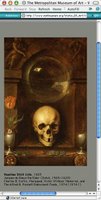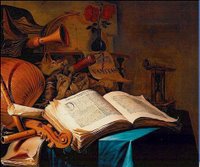Wednesday, May 23, 2007
Monday, December 04, 2006
(62) chronology: 1520


The simplest way to remember that the knife and two ears represent the year 1520 is to observe the way, from a distance, they seem to loom over and threaten the Tree-man. They are a mnemonic both for the glyph 2-Tecpatl and for the year 1520, that is the year before the fall of Tenochtitlán.
 The chronology looks back from the standpoint of sometime in the year 1528, and sees the 1527 Sack of Rome as a repeat of the 1521 fall of Tenochtitlán. The year 1520 and its difficult-to-remember name in the indigenous chronology are represented in the triptych as “the year before” the milestone. It was a year when (in retrospect) Cortés posed a threat to Tenochtitlan, but more importantly from a European perspective it was a year when Martin Luther already posed a threat to Rome.
The chronology looks back from the standpoint of sometime in the year 1528, and sees the 1527 Sack of Rome as a repeat of the 1521 fall of Tenochtitlán. The year 1520 and its difficult-to-remember name in the indigenous chronology are represented in the triptych as “the year before” the milestone. It was a year when (in retrospect) Cortés posed a threat to Tenochtitlan, but more importantly from a European perspective it was a year when Martin Luther already posed a threat to Rome.In other words, to remember that the year before 1521 was represented in an indigenous codex by a knife and two dots, all one had to do was remember the bizarre image of a knife and ears looming over a hellish scene. The explanation of what the knife had to do with Martin Luther is obscure, as if to take into account that Luther was an obscure person. The initial on the knife is easier to remember than to decipher.
Monday, November 20, 2006
(61) chronology: 1520
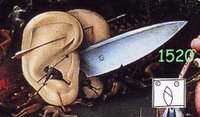
The combination of ears and knife might also have been fairly easy to read as a European hieroglyph for speech, similar to the artist R.B. Kitaj’s cover design for John R. Searle, Speech Acts. On the cover of an anthology of letters from Subcomandante Marcos, Desde las montañas del sureste mexicano, negative connotations have disappeared altogether.
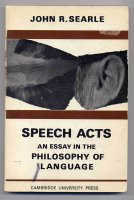
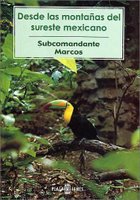
(60) chronology: 1520

 The mnemonic/translation for 2-Flint/ome tecpatl in The Garden of Delights/El Jardín de las Delicias is a European style knife. It might have been confusing for Spanish speakers that the word tecpatl can mean flint (pedernal), a knife (cuchillo), or a day or year, but not extremely confusing since there are flint knives in the Bible. The problem seems to be that whereas in a European language “flint knife” only calls to mind a vague image since knives are no longer made of flint, a tecpatl or a picture of one sometimes had a face with eyes and teeth, and looked like a fish when turned sideways. A translation into Nahuatl would have had to go from a fairly neutral word to one loaded with unknown connotations. The image in The Garden of Delights/El Jardín de las Delicias translating the glyph tecpatl to a picture of a knife is relatively simple.
The mnemonic/translation for 2-Flint/ome tecpatl in The Garden of Delights/El Jardín de las Delicias is a European style knife. It might have been confusing for Spanish speakers that the word tecpatl can mean flint (pedernal), a knife (cuchillo), or a day or year, but not extremely confusing since there are flint knives in the Bible. The problem seems to be that whereas in a European language “flint knife” only calls to mind a vague image since knives are no longer made of flint, a tecpatl or a picture of one sometimes had a face with eyes and teeth, and looked like a fish when turned sideways. A translation into Nahuatl would have had to go from a fairly neutral word to one loaded with unknown connotations. The image in The Garden of Delights/El Jardín de las Delicias translating the glyph tecpatl to a picture of a knife is relatively simple.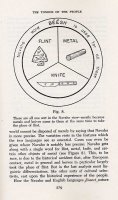 On the other hand in the twentieth century the anthropologist Clyde Kluckhorn found the idea of using the same Navajo word for an old arrowhead, a new knife, and metal complicated enough to warrant a diagram with both words and pictures. (The page shown here is from the 1974 paperback edition of The Navaho.)
On the other hand in the twentieth century the anthropologist Clyde Kluckhorn found the idea of using the same Navajo word for an old arrowhead, a new knife, and metal complicated enough to warrant a diagram with both words and pictures. (The page shown here is from the 1974 paperback edition of The Navaho.)
(59) counting and measuring time
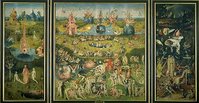 The Garden of Delights/El Jardín de las Delicias differs from many vanitas images in the sense that it does not include much in the way of images of time measuring, for instance clocks and hourglasses, although it does include images of pain that would increase over time, fruit that could go bad,
The Garden of Delights/El Jardín de las Delicias differs from many vanitas images in the sense that it does not include much in the way of images of time measuring, for instance clocks and hourglasses, although it does include images of pain that would increase over time, fruit that could go bad,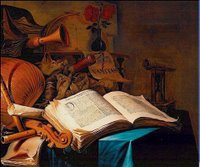 boats that could capsize, etc.
boats that could capsize, etc. The emphasis is on counting time, with two daytime scenes and one night scene. The obvious link is to Genesis where time is marked by days (defined as evening and morning, Appellavitque lucem Diem, et tenebras Noctem: factumque est vespere et mane, dies unus). There is also musical notation in the right panel, which also seems to relate to counting time. There is a complex series of images relating to the Jewish calendar, which involves counting days and full moons, and there is a series of images marking years in an eccentric version of Nahuatl picture writing. The explanations will be long and complicated both for the Jewish calendar and the Nahuatl annals, both of which seem to be memory systems devised for learning and recalling, but it seems worth noting at the start that the point seems to have been to emphasize and facilitate translating one into the other. Measuring time in terms of hours or even relative age (as in the steadily decaying books in the painting by Jan Lievens) could come later.
The emphasis is on counting time, with two daytime scenes and one night scene. The obvious link is to Genesis where time is marked by days (defined as evening and morning, Appellavitque lucem Diem, et tenebras Noctem: factumque est vespere et mane, dies unus). There is also musical notation in the right panel, which also seems to relate to counting time. There is a complex series of images relating to the Jewish calendar, which involves counting days and full moons, and there is a series of images marking years in an eccentric version of Nahuatl picture writing. The explanations will be long and complicated both for the Jewish calendar and the Nahuatl annals, both of which seem to be memory systems devised for learning and recalling, but it seems worth noting at the start that the point seems to have been to emphasize and facilitate translating one into the other. Measuring time in terms of hours or even relative age (as in the steadily decaying books in the painting by Jan Lievens) could come later.
There are also publication dates, of which the most striking is the 1492 publication of Nebrija’s Gramática de la lengua castellana, represented by a hieroglyph that Nebrija described in the text. These are helpful for establishing the date of the triptych, although in some instances the artist might have known about a book that was not yet published, and it is also interesting that printed title pages that include years of publication are not very dissimilar to Nahuatl annals. A title page often includes some sort of picture, and a year in Roman or Arabic numerals, and title pages might have seemed less peculiarly European than the rest of the book.
(58) Pearls Before Swine and Metallica
Chorus:
Dit Dit Dah Dit
Dit Dit Dah
Dah Dit Dah Dit
Dah Dit Dah
It was notorious at the time since
'…It got Murray the K in trouble.’
The New York deejay played ‘(Oh Dear) Miss Morse’ on AM radio. It turned out that very few people knew Morse code, but among them was every Boy Scout in America. (Washington Post)
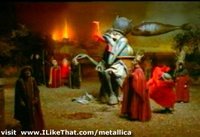 The video of Metallica’s “Until It Sleeps” (1996; originally on the 1996 album Load, and also on a compilation DVD to be released in December, 2006) includes images adapted from The Garden of Delights/El Jardín de las Delicias, and since the band is well known ther
The video of Metallica’s “Until It Sleeps” (1996; originally on the 1996 album Load, and also on a compilation DVD to be released in December, 2006) includes images adapted from The Garden of Delights/El Jardín de las Delicias, and since the band is well known ther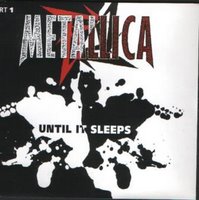 e is an explanation that goes beyond the lyrics by James Hetfield and Lars Ulrich to say that the song has to do with Hetfield’s father dying of cancer and refusing medical treatment because of his religious beliefs.
e is an explanation that goes beyond the lyrics by James Hetfield and Lars Ulrich to say that the song has to do with Hetfield’s father dying of cancer and refusing medical treatment because of his religious beliefs.
Wednesday, November 15, 2006
(57) vanitas
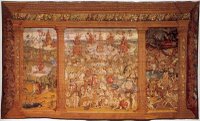
Here is where the question of the “viewer” seems to have to be considered, since to any reasonable person it seems cold and harsh for “vanitas vanitatum dixit Ecclesiastes vanitas vanitatum omnia vanitas (vanity of vanities, said Ecclesiastes: vanity of vanities, and all is vanity)” to be the major theme of a history painting representing the conquest of Mexico. It seems likely that this is the reason that there is no surviving Dutch commentary on the tapestries based on The Garden of Delights/El Jardín de las Delicias that were completed in the Netherlands in the 1560s for two successive governors. The tapestries were in the style of a Dutch artist and seemed to prioritize sunbathing and fruit eating over thinking about events in Mexico or the 1527 sack of Rome, with the implication that northern artists and perhaps by extension the rest of the population took a frivolous view of things.
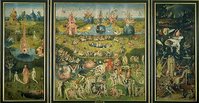 Although there is as far as I know no record of Juana la Loca having received the original triptych, the bizarre iconography would have made some sense in terms of her circumstances when she was living at Tordesillas, since she was criticized for neglecting her health to the point of refusing to eat, but was also observed on occasion to be lucid and rational, and she had been reputed to be well educated and intelligent as a girl. It would have been reasonable to focus on health first, then news of the world.
Although there is as far as I know no record of Juana la Loca having received the original triptych, the bizarre iconography would have made some sense in terms of her circumstances when she was living at Tordesillas, since she was criticized for neglecting her health to the point of refusing to eat, but was also observed on occasion to be lucid and rational, and she had been reputed to be well educated and intelligent as a girl. It would have been reasonable to focus on health first, then news of the world.
 A famous biombo represents similar ideas in a different way, where the rebuilt city on one side of the screen obviously comes after the war shown on the other side.
A famous biombo represents similar ideas in a different way, where the rebuilt city on one side of the screen obviously comes after the war shown on the other side.
Friday, November 03, 2006
(56) vanitas and books
 The art history library at UC Berkeley is like a vanitas still life, with a clock visible through the window next to graduate students' shelves for books relating to projects they are trying to complete. The campanile is used for storing fossils from the La Brea tar pits, and when there is a special lecture there are wine, bread, bottled water, and grapes or strawberries, and there are people with and without gray hair, and the uncomfortable chairs seen in the picture at the left. During a lecture, with the lights out in order to show slides, it is impossible to read the books, and the wine is usually not opened until after the lecture.
The art history library at UC Berkeley is like a vanitas still life, with a clock visible through the window next to graduate students' shelves for books relating to projects they are trying to complete. The campanile is used for storing fossils from the La Brea tar pits, and when there is a special lecture there are wine, bread, bottled water, and grapes or strawberries, and there are people with and without gray hair, and the uncomfortable chairs seen in the picture at the left. During a lecture, with the lights out in order to show slides, it is impossible to read the books, and the wine is usually not opened until after the lecture.The Garden of Delights/El Jardín de las Delicias predates the typical vanitas paintings of the seventeenth century, which makes it more difficult to see as an illustration of the book of Ecclesiastes, but it is really simpler. The center panel has to do with enjoying life in the present since it is soon followed by death, shown in the right panel.
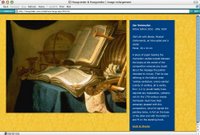 In the seventeenth century paintings the idea that "Of making many books there is no end: and much study is an affliction of the flesh" (Ecclesiastes 12:12) is expressed by painted books where the pages can never be turned, and in The Garden of Delights/El Jardín de las Delicias there is practically no end to the books illustrated and the time it would take to explain all the allusions to books. The triptych's organization is reminiscent of hypertext as seen in libraries, systems for memory, concordances, and commentaries. The obscurity of the references to books serves a purpose, which is to remind the viewer that it would be better to do something like go outdoors and eat strawberries.
In the seventeenth century paintings the idea that "Of making many books there is no end: and much study is an affliction of the flesh" (Ecclesiastes 12:12) is expressed by painted books where the pages can never be turned, and in The Garden of Delights/El Jardín de las Delicias there is practically no end to the books illustrated and the time it would take to explain all the allusions to books. The triptych's organization is reminiscent of hypertext as seen in libraries, systems for memory, concordances, and commentaries. The obscurity of the references to books serves a purpose, which is to remind the viewer that it would be better to do something like go outdoors and eat strawberries.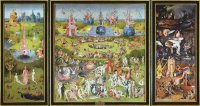 At the same time, the books illustrated in The Garden of Delights/El Jardín de las Delicias have become obscure for various reasons, including the destruction of books in New Spain. The artist was so successful at conveying the idea of "nothing new under the sun" (Ecclesiastes 1:10) that the triptych has been regarded as the work of Hieronymus Bosch, who died before Europeans arrived on the mainland, which means that the attempt to convey that studying Nahuatl books was wearisome has not even been noticed. The detail is interesting since it seems to shed some light on the interactions between Europeans and Indians, as seen from the artist's perspective.
At the same time, the books illustrated in The Garden of Delights/El Jardín de las Delicias have become obscure for various reasons, including the destruction of books in New Spain. The artist was so successful at conveying the idea of "nothing new under the sun" (Ecclesiastes 1:10) that the triptych has been regarded as the work of Hieronymus Bosch, who died before Europeans arrived on the mainland, which means that the attempt to convey that studying Nahuatl books was wearisome has not even been noticed. The detail is interesting since it seems to shed some light on the interactions between Europeans and Indians, as seen from the artist's perspective.(see here later for a note on how the foregoing comments follow José de Sigüenza's chapter on the paintings in the Escorial)
Thursday, November 02, 2006
Sunday, October 29, 2006
Apelles


from Pliny, Historia Naturalis, book 35
(an older English translation is online on the Perseus website)
Tuesday, October 03, 2006
(55) ways of recording dates
 Ramirez read the row of circles at the bottom of the drawing as a way of marking the year 1537, i.e. in the fourth year before 1540. But an easier way to make sense of the date seems to be to relate it to Bartholome de las Casas, even though his Brevísima relación de la destrucción de las Indias was not published until 1552.
Ramirez read the row of circles at the bottom of the drawing as a way of marking the year 1537, i.e. in the fourth year before 1540. But an easier way to make sense of the date seems to be to relate it to Bartholome de las Casas, even though his Brevísima relación de la destrucción de las Indias was not published until 1552.The Indies were discovered in the year one thousand four hundred and ninety-two. In the following year a great many Spaniards went there with the intention of settling the land. Thus, forty-nine years have passed since the first settlers penetrated the land, the first so claimed being the large and most happy isle called Hispaniola, which is six hundred leagues in circumference.It takes some mental arithmetic to realize that the book was written in 1542 and published ten years later, and since Las Casas was a priest it seems to make sense to understand the 49 years as an allusion to Biblical time, specifically the Jubilee of Leviticus 25.Around it in all directions are many other islands, some very big, others very small, and all of them were, as we saw with our own eyes, densely populated with native peoples called Indians. This large island was perhaps the most densely populated place in the world. There must be close to two hundred leagues of land on this island, and the seacoast has been explored for more than ten thousand leagues, and each day more of it is being explored. And all the land so far discovered is a beehive of people; it is as though God had crowded into these lands the great majority of mankind.
If the artist who made the drawing of the events in Coyoacan was also counting forward from 1492 the "four years before forty years" implied by the row of circles with a cross marking a point four units before the end of the row might imply something similar to the way Las Casas reckoned the date of the Brevissima Relacion. It is almost as long as the 40 years the Children of Israel spent wandering in the desert. The "four years before forty years" may be a combination of a Biblical unit of time and an American preference for exact dates. Counting forward from 1492 and adding 36 completed years would be equivalent to 1528, before Cortés returned to Spain.
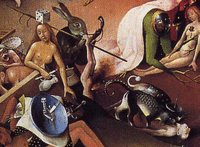 Even though the drawing obviously represents specific events, and whether or not the 40 circles have to do with counting forward from 1492, they seem to be a way of emphasizing, as Las Casas did, that similar incidents took place over a very long period of time. There is something similar in The Garden of Delights/El Jardín de las Delicias where an incident of a person being attacked by dogs is located near a date sign that in the context of a series of dates make the most sense as 4-Rabbit, then again as 8-Rabbit. (Looking at photographs taken before the triptych was restored, the sides of the cube were apparently once two 4's and a 2, as though someone were cheating at a dice game.) Similar incidents might just as well have taken place in 2, 4, 6, 8, or 10-Rabbit (or any year, taking into account all six surfaces) and the seeming imprecision emphasizes that as Las Casas kept saying, such incidents were ongoing.
Even though the drawing obviously represents specific events, and whether or not the 40 circles have to do with counting forward from 1492, they seem to be a way of emphasizing, as Las Casas did, that similar incidents took place over a very long period of time. There is something similar in The Garden of Delights/El Jardín de las Delicias where an incident of a person being attacked by dogs is located near a date sign that in the context of a series of dates make the most sense as 4-Rabbit, then again as 8-Rabbit. (Looking at photographs taken before the triptych was restored, the sides of the cube were apparently once two 4's and a 2, as though someone were cheating at a dice game.) Similar incidents might just as well have taken place in 2, 4, 6, 8, or 10-Rabbit (or any year, taking into account all six surfaces) and the seeming imprecision emphasizes that as Las Casas kept saying, such incidents were ongoing.
Wednesday, September 20, 2006
(54) Potential misreadings
 Even in recent paintings, the possibility exists that viewers might misconstrue pictures of innocents in hellish situations as hell scenes. In the exhibition catalogue for Cheech Marin's Chicano Visions, p. 117, Frank Romero's 1996 painting The Arrest of the Paleteros is carefully explained:
Even in recent paintings, the possibility exists that viewers might misconstrue pictures of innocents in hellish situations as hell scenes. In the exhibition catalogue for Cheech Marin's Chicano Visions, p. 117, Frank Romero's 1996 painting The Arrest of the Paleteros is carefully explained:Paleteros, or ice cream men, were the most innocent and representative of transplanted Mexican culture in Los Angeles. The fact that they were frequently arrested for not having vendor permits attests to the kind of ludicrous racial prejudice that exists besides the other truly serious dangers of Echo Park.
The detail shown here is from the museum website.
Wednesday, September 13, 2006
(53) legal implications
 A consequence of the way the years are mapped onto the triptych format, so that bad years go in the hell scene, is that when the years include crimes that have victims, the victims are in the hell scene too. The picture of a person attacked by dogs resembles a medieval artist's way of showing torments after death, but it is also a condemnation of the practice of, according to reports, literally feeding people to dogs as a means of intimidation.
A consequence of the way the years are mapped onto the triptych format, so that bad years go in the hell scene, is that when the years include crimes that have victims, the victims are in the hell scene too. The picture of a person attacked by dogs resembles a medieval artist's way of showing torments after death, but it is also a condemnation of the practice of, according to reports, literally feeding people to dogs as a means of intimidation.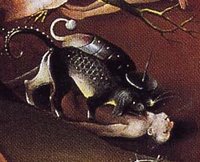
Such an event was reported to have taken place in Cholula in 1519. The document shown just below

Friday, September 01, 2006
(52) organization of the triptych
 The organization of The Garden of Delights/El Jardín de las Delicias combines elements from different cultures into a hybrid memory system. The year signs are loci for remembering events that took place over the course of ten years. Perhaps since it is not easy to remember ten of anything (psychologists expect people to be able to remember more or less seven digits), or perhaps to make sure to remember good and bad, the years are placed in different locations on a conventional looking triptych. Cortés landed in New Spain in a good year, and the year after that was a bad year. The triptych format not only organizes memories of years but also serves as a model of a Biblical tabernacle.
The organization of The Garden of Delights/El Jardín de las Delicias combines elements from different cultures into a hybrid memory system. The year signs are loci for remembering events that took place over the course of ten years. Perhaps since it is not easy to remember ten of anything (psychologists expect people to be able to remember more or less seven digits), or perhaps to make sure to remember good and bad, the years are placed in different locations on a conventional looking triptych. Cortés landed in New Spain in a good year, and the year after that was a bad year. The triptych format not only organizes memories of years but also serves as a model of a Biblical tabernacle.
Tuesday, August 29, 2006
(51) la noche triste, 1520
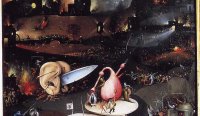 The main differences between the image of Cortés's nighttime retreat from Tenochtitlán in 1520 (la noche triste) on The Garden of Delights/El Jardín de las Delicias and on a later biombo are that the biombo includes more identifiable scenes and that it has a key indicating that la noche triste is marked with the letter H (near the bottom of the third panel from the right).
The main differences between the image of Cortés's nighttime retreat from Tenochtitlán in 1520 (la noche triste) on The Garden of Delights/El Jardín de las Delicias and on a later biombo are that the biombo includes more identifiable scenes and that it has a key indicating that la noche triste is marked with the letter H (near the bottom of the third panel from the right).The Garden of Delights/El Jardín de las Delicias version is also obviously a hell scene (setting aside for the moment the question of whether there were similar battle scenes in hell before the imitation-Bosch paintings) but that may be primarily because the knife has to do with Martin Luther.


Monday, August 28, 2006
(50) a Leonardo parody
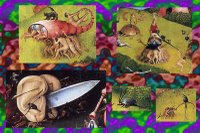
 The gigantic ears and knife are only one of several parodies of Leonardo da Vinci's numerous designs for real and preposterous war machines (see the notes for another Leonardo parody). An interesting difference is that none of the ones in The Garden of Delights/El Jardín de las Delicias has wheels. They may be a comment on the Indians not having the equivalent of European war machines, especially since the only easy-to-recognize American artifact in the triptych is a feathered disc which might have reminded people of European armor but whose main military purpose would have been to look impressive.
The gigantic ears and knife are only one of several parodies of Leonardo da Vinci's numerous designs for real and preposterous war machines (see the notes for another Leonardo parody). An interesting difference is that none of the ones in The Garden of Delights/El Jardín de las Delicias has wheels. They may be a comment on the Indians not having the equivalent of European war machines, especially since the only easy-to-recognize American artifact in the triptych is a feathered disc which might have reminded people of European armor but whose main military purpose would have been to look impressive.
The right-side-up and upside-down people transporting one of the "war machines" may be demonstrating what wheels might have looked like from an Indian perspective, or according to an Indian joker. The image of people going around and around on a wheel of fortune is European.
Wheels are shown as dangerous things in the Haywain triptychs.
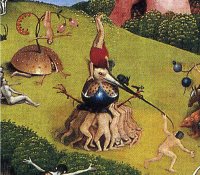

Wednesday, August 23, 2006
(49) a real murder mystery



This blog has been on a long digression between 1519 (ce acatl, marked by the pink castle; see 32 and 33 in the May archive and 1 in April) and 1520 (ome tecpatl, marked by the ears and knife) in order to establish a context for the peculiar way in which New World dates were "translated" into images that look like inventions of Hieronymus Bosch. Apart from the glyph and the enigmatic monogram on the knife, in The Garden of Delights/El Jardín de las Delicias the year 1520 is marked mainly by darkness, violence, and confusion.
Controversy over what happened in that year and how to interpret the events still exists. It was announced today that some skeletal remains have been examined and that they show invaders were killed and eaten. Archaeologists have put a positive spin on the story, saying the evidence shows there was "resistance to the conquest… It shows it wasn't all submission. There was a fight." The story will probably also be taken to indicate that people thought the problem of the European invasion could be solved by eating conquistadores and their friends.
An article based on another interview with the same archaeologist was published in La Jornada on August 2.Boiled bones show Aztecs butchered, ate invaders
By Catherine Bremer
CALPULALPAN, Mexico (Reuters) - Skeletons found at an unearthed site in Mexico show Aztecs captured, ritually sacrificed and partially ate several hundred people traveling with invading Spanish forces in 1520.
Skulls and bones from the Tecuaque archaeological site near Mexico City show about 550 victims had their hearts ripped out by Aztec priests in ritual offerings, and were dismembered or had their bones boiled or scraped clean, experts say.
The findings support accounts of Aztecs capturing and killing a caravan of Spanish conquistadors and local men, women and children traveling with them in revenge for the murder of Cacamatzin, king of the Aztec empire's No. 2 city of Texcoco.
Experts say the discovery proves some Aztecs did resist the conquistadors, led by explorer Hernan Cortes, before the Spaniards attacked the Aztec capital, Tenochtitlan, now Mexico City.
History books say many indigenous Mexicans welcomed the white-skinned horsemen in the belief they were returning gods but turned against the Spaniards once they tried to take over the Aztec seat of power in a conflict that ended in 1521.
"This is the first place that has so much evidence there was resistance to the conquest," said archaeologist Enrique Martinez, director of the dig at Calpulalpan in Tlaxcala state, near Texcoco.
"It shows it wasn't all submission. There was a fight."
The caravan was apparently captured because it was made up mostly of the mulatto, mestizo, Maya Indian and Caribbean men and women given to the Spanish as carriers and cooks when they landed in Mexico in 1519, and so was moving slowly. Continued...
Sunday, August 20, 2006
(48) The Concrete Blonde

"Bosch looked up from the paper into the grimy but familiar face of the homeless man who had staked out the front of the courthouse as his turf. Bosch had seen him out here every day during the week of jury selection, making his change-and-cigarette rounds. The man wore a threadbare tweed jacket over two sweaters and corduroy pants. He carried a plastic bag of belongings and a Big Gulp cup to shake in front of people when he asked for change. He also always carried with him a yellow legal pad with scribbling all over it." Michael Connelly, The Concrete Blonde, p. 9. (Thank you to "Caro" on the general discussion message board at www.michaelconnelly.com, who remembered the book.)
Saturday, August 19, 2006
(47) the Rhetorica ad Herennium



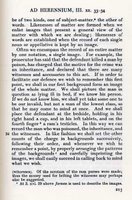
At first glance, and also from reading surveys of the medieval commentary on it, the Rhetorica ad Herennium memory system seems excessively difficult. To start with, one seems to have to be able to visualize a long colonnade, with every fifth or even every tenth space marked in some distinctive way. In the Palace of Charles V in Granada, the doors and niches behind the columns might help a little as reference points for counting off every fifth intercolumniation (space between columns), although not much. It does not seem as though having such a space nearby would help remember things.

But there may have been an easier way. In one of the Harry Bosch detective novels, there is a memorable scene where Harry Bosch and an unidentified person share a cigarette on the steps of a courthouse in Los Angeles.
(see the notes page for medieval commentaries and Harry Bosch novels)
